- Visibility 50 Views
- Downloads 4 Downloads
- DOI 10.18231/j.agems.2020.004
-
CrossMark
- Citation
Challenges of memory enhancers
- Author Details:
-
Sunil Chaudhry *
Introduction
Definition
Memory is the mental faculty of retaining and recalling past experience based on the mental processes of learning, retention, recall and recognition. Memory is the process in which information is encoded, stored, and retrieved. It is the ability to remember past experiences, and the power or process of recalling to mind previously learned facts, experiences, impressions, skills and habits. The Global cognitive and memory enhancer drugs market was valued at $3,680 million in 2016, and is projected to reach $6,598 million by 2023, growing at a CAGR of 8.6% from 2017 to 2023.[1]
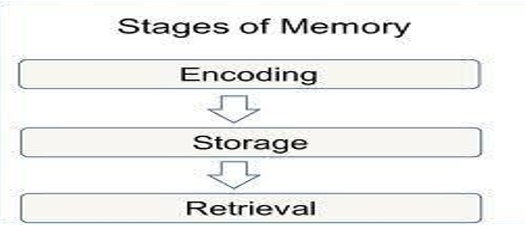
The three main stages of memory
Encoding: information comes into our memory system (from sensory input), it needs to be changed into a form that the system can cope with, so that it can be stored.
Storage: nature of memory stores, i.e., where the information is stored, how long the memory lasts for (duration). Storage capacity is an amount over 74 Terabytes (just in the cerebral cortex alone) and there are 125 trillion synapses.[2]
Recall or retrieval: of memory refers to the subsequent re-accessing of events or information from the past, which has been previously encoded and stored in the brain.
Memory formation
During the process of learning and memory formation, brain undergoes a physical and chemical change which is called as synaptic plasticity. It shows involvement of various signal transduction pathways, induction of gene expression which results in formation of new synapses between nerve cells.
Types of memory
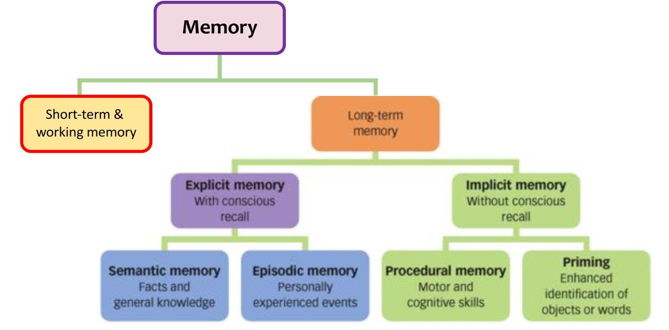
Short-term memory is the information that a person is currently thinking about or is aware of. It is also called primary or active memory. Recent events and sensory data such as sounds are stored in short-term memory. Short-term memory often encompasses events over a period anywhere from 30 seconds to several days. Shortterm memory stores are small and the contents are soon lost unless repeatedly refreshed.
Long-term memory refers to the storage of information over an extended period. Long term memory stores are very large but are not always readily accessible.
Explicit memory is the conscious, intentional recollection of factual information, previous experiences, and concepts. Explicit memory can be divided into two categories: episodic memory, which stores specific personal experiences, and semantic memory, which stores factual information.
Implicit memory is sometimes referred to as unconscious memory or automatic memory. Implicit memory uses past experiences to remember things without thinking about them.- Taking a familiar route each day, such as commuting to work or the store where you shop frequently, Buttoning a shirt Dialing a phone, Brushing your teeth , Typing on a keyboard.
Cognitive impairment is when a person has trouble remembering, learning new things, concentrating, or making decisions that affect their everyday life. Cognitive impairment ranges from mild to severe.[3]
Memory circuit in Brain
The Papez circuit like many other areas of the limbic system is involved in learning and memory, emotion, and social behavior, and was originally thought (by James Papez) to the anatomical substrate of emotional experience and memory. The Papez circuit, comprising connections between the hippocampus, medial diencephalon and cingulate gyrus is vital for episodic memory
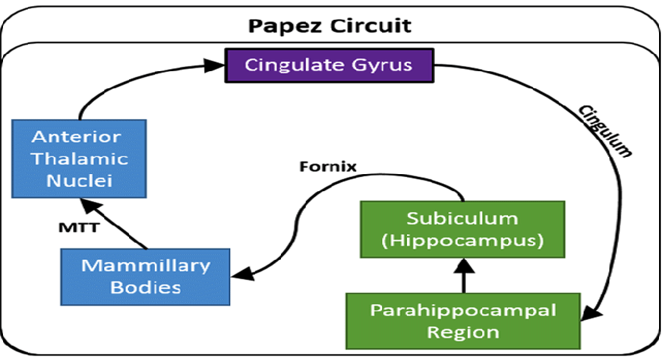
Gudden identified atrophy to the mammillary body in cases of Korsakoff’s syndrome, for which amnesia is a key feature and memory loss.[4]
Causes of Memory loss
Dementia is a term used to describe a decline in mental abilities, including memory, language, and logical thinking, that is severe enough to affect daily living. Alzheimer disease is a neurodegenerative dementia, which means that the dementia causes loss of brain tissue and is not reversible. The causes of dementia include Alzheimer's disease. Vascular cognitive impairment Other irreversible medical conditions that can cause dementia (at a much lower rate) include, for example, Parkinson’s disease, Huntington’s disease, Pick’s disease, or Creutzfeldt-Jakob disease, Patients od dementia have difficulty in everyday tasks, confusion in familiar environments, difficulty with words and numbers, changes in mood and behaviour and memory loss. At present, the treatments available for dementia cannot reverse the underlying degeneration of brain cells, although they may temporarily improve or delay decline in cognitive function. Dementia is considered to be an expensive medical illness and the potential costs are huge as conditions associated with. Dementia are typically progressive and irreversible. With the increase in the elderly population, there would be a proportionate rise in elderly suffering from dementia as the prevalence of dementia in the elderly is 5%–7%.[5]
Clinical causes of Memory Disorders
Alzheimer’s disease
Senile plaques (SPs) and Neuro fibrillary tangles (NFTs) are considered the key pathological hallmarks of AD.
Numerous hypotheses have been put forward on the basis of the various causative factors in order to explain this multifactorial disorder. Some of them included are:
• Cholinergic hypothesis
• Amyloid beta hypothesis
• Tau hypothesis
• Inflammation hypothesis
In recent times it has been shown that the most commonly used Amyloid beta hypotheses, prevailing for the last two decades, does not relate to the complex Pathophysiology of this draining disease. Amyloid beta oligomers in synaptic injury, suggesting that these are first and foremost among several other signals that destroy the reliability of brain
functions. Amyloid plaques formation are develop in thelater age, these Amyloid beta oligomers leads to cognitive impairment due neurotoxicity.[6]
Epilepsy and changes in memory:
Impairment in cognitive abilities like problems of memory and concentration was observed in up to 48% of patients with convulsive disorder, taking single anticonvulsive medication. Topiramate belonging from newer antiepileptic drugs seems to be responsible for causing difficulties in attention and dysfunction of verbal abilities. Those on valporic acid therapy, attention appears to be impaired with 10% of patients on valporic acid therapy.[7]
Other causes of dementia
Corticobasal degeneration, Creutzfeldt-Jakob disease, Huntington's disease Frontotemporal dementia, Progressive Supranuclear palsy, Mild Cognitive impairment.
Drugs causing memory loss
• Antianxiety drugs (Benzodiazepines)
• Cholesterol-lowering drugs (Statins)
• Antiepileptics
• Antidepressant drugs (Tricyclic antidepressants) ...
• Narcotics
• Parkinson's drugs (Dopamine agonists)
• Hypertension drugs (Beta-blockers)
• Nonbenzodiazepine sedative-hypnotics
Drugs for memory
Memory enhancers are often referred to as "smart drugs", "cognitive enhancers", "brain enhancers" or in the scientific literature as nootropics
Synthetic Memory enhancers
No cure is presently available for most forms of dementia, including AD. Medical treatments are, therefore, symptomatic and many of them are targeted to the most obvious and quantifiable symptom, i.e. decline in cognitive function.
| Pathophysiological mechanism with relevance to AD | Pharmacotherapy |
| Neurotransmission | Cholinesterase inhibitors |
| Excitotoxicity | Memantine |
| Oxidative stress | Gingko biloba Tocopherol (vitamin E) Selegiline Α-Lipoid acid |
| Neuroinflammation | NSAIDs Peroxisome proliferator-activated Receptor y agonists |
| Neurotrophic factors | Estrogens Insulin |
| Amyloid metabolism | HMG-CoA reductase inhibitors |
NICE The National Institute for Health and Care Excellence UK
Recommends that Acetylcholinesterase inhibitors are clinically cost effective and has recommended their use in mild to moderate Alzheimer’s Disease. NICE also recommends they be considered for people with dementia with Lewy bodies and patients with Alzheimer’s Disease, Cholinesterase inhibitors should be used with caution in people with asthma and COPD.
Memantine is a glutamate receptor antagonist licensed for the treatment of moderate to severen Alzheimer’s disease. Memantine is not licensed for use in combination with Acetylcholinesterase inhibitors.
Metrifonate ameliorated the impairment of learning in both scopolamine-treated and basal forebrain-lesioned rats by not only increasing extracellular acetylcholine levels by inhibiting cholinesterase, was evaluated in clinical trials but was discontinued because of property to cause respiratory depression.
Piracetam share a 2-pyrrolidone nucleus and are derivatives of gamma-aminobutyric acid (GABA), which acts as a major inhibitory neurotransmitter in the brain. Piracetam is a positive allosteric modulator of the AMPA receptor.. At a neuronal level, piracetam modulates neurotransmission in a range of transmitter systems (including cholinergic and glutamatergic), has neuroprotective and anticonvulsant properties, and improves neuroplasticity. Its efficacy is documented in cognitive disorders and dementia, vertigo, cortical myoclonus, dyslexia. Piracetam is well tolerated. It commonly prescribed for cognitive impairment and dementia in several countries of continental Europe.
Combination of citicoline and piracetam is available in market as fixed dose combination in film coated tablet with dose of citicoline 500 mg and piracetam 800 mg. The combination is generally prescribed for memory enhancement, neurological and cognitive disorder, Parkinsonism and Alzheimer disorder .Evidence has surfaced that citicoline counteracts the deposition of betaamyloid, a neurotoxic protein believed to play a central role in the pathophysiology of Alzheimer’s disease (AD). Citicoline is a naturally occurring nontoxic and well-tolerated drug that is an essential intermediate for the synthesis of phosphatidylcholine, a major constituent of the gray matter of brain tissue. Citicoline promotes brain metabolism by enhancing the synthesis of acetylcholine and restoring phospholipids content in the brain.[9]
| Cognitive enhancer | Neuromodulatory mechanism | Cognitive function improved | Known brain system most affected | Currently recommended clinical use |
| Methylphenidate, amphetamine | Dopamine and noradrenaline reuptake inhibitors | Response inhibition, working memory, attention vigiliance | Frontoparietal attentional system, striatum, default mode networks | ADHD, wake-promoting agent |
| Caffeine | Non-selective adenosine receptor antagonist | Vigilance, working memory, incidental learning | Frontal lobe attentional systems | - |
| Nicotine | Nicotinic cholinergic receptor agonist | Working memory, episodic memory, attention | Fronto-parietel attentional systems, medial temporal lobe, default mode networks | - |
| Modafinil | Unknown, but effects on dopamine, noradrenaline and orexin systems proposed | Working memory episodic memory, attention | Frontal lobe attentional systems | Wake- promoting agent |
| Atomaxetine, reboxetine Donepezil, galatamine, rivastigmine (AChEi) Memantine | Noradrenaline reuptake inhibitors Blocks enzymatic breakdown of acetylcholine Noncompetitive, low-affinity, open channel blocker of the NMDA receptore | Response inhibition, working memory, attention Episodic memory, attention Episodic memory, attention | Frontoparietal attentional systems Frontal lobe attentional systems Frontal and Parietel lobe | ADHD, depression Alzheimer’s disease, PDD, DLB Alzheimer’s disease |
Role of Neurotransmitters in Memory[11]
The neurotransmission with regard to memory formation, storage and retrieval involves numerous neurotransmitters importantly dopamine, Ach, NE, NMDA, GABA. [Figure 4]
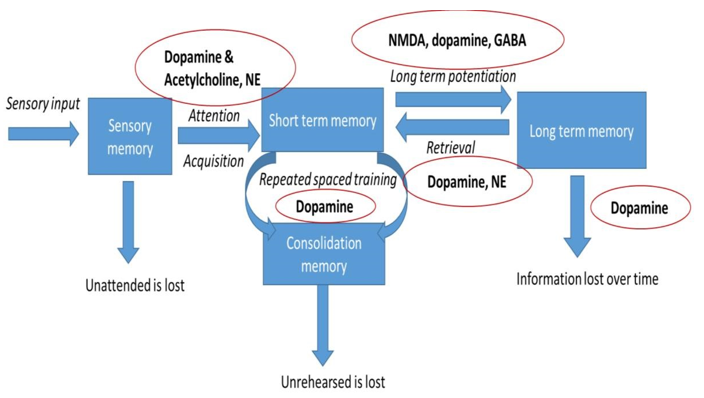
Major neurotransmitters and their role in memory.
Dopamine has been strongly linked with working memory (WM) and attention, whereas serotonergic drugs have been prominently associated with affective processes However, serotonergic modulation can also influence WM as can noradrenaline and acetylcholine. Conversely, dopamine influences affective processing. For instance, dopamine, noradrenaline and acetylcholine release is under histaminergic H3 heteroreceptor control, whereas noradrenaline and dopamine can interact to modulate spatial WM neuronal responses in prefrontal cortex in a synergistic fashion. AChEIs such as rivastigmine and donepezil are now widely used to treat Parkinson’s disease dementia (PDD) and the related condition of dementia with Lewy bodies (DLB). Other drugs are Tacrine and Galantamine. ACH agonists also stimulate LTM such as Nefiracetam Many clinical trials have reported modest global beneficial effects of such drugs on bedside cognitive screening tests. For example, in young volunteers, donepezil improves episodic memory, whereas healthy elderly subjects show improvements in verbal memory. Similar considerations as for AChEIs also apply to modafinil, which has become a popular drug for cognitive enhancement in healthy individuals.
AMPA receptor, AMPAR, or quisqualate receptor) is anionotropic trans membrane receptor for glutamate that mediates fastsynaptictransmission in thecentral nervous system(CNS).
AMPARs play a key role in this process, as one of the key indicators of Long term memory AMPA.
Receptor Endocytosis as a Neurobiological Mechanism of Forgetting. NMDA, AMPA and Kainate receptors are members of the ionotropic class of glutamate receptors. piracetam and aniracetam, were among the first of this class of drugs to be discovered. AMPA receptor subtypes GluA2 and GluA3 bind with piracetam and a corresponding structure of GluA3 bind with aniracetam In those individuals destined to develop Alzheimer's disease, other abnormalities (eg, amyloidopathy and oxidative stress) interact to increase NMDA receptor hypofunction (NRHypo) burden. Memantine, low-affinity NMDAR channel blocker, has been used in the treatment of moderate to severe AD.
Phosphodiesterase inhibitors (PDE-I) enhance cAMP and/or cGMP signaling via reducing the degradation of these cyclic nucleotides. Since both cAMP and cGMP signaling are essential in a variety of cellular functions, including neuroplasticity and neuroprotection, PDE-Is are receiving increased attention as possible targets for treatment of age-related cognitive decline as well as Alzheimer’s disease (AD). A single dose of sildenafil improves cerebral hemodynamic function and increases cerebral oxygen metabolism in patients with AD. These drugs are under evaluation.[12]
| Alchohol misuse | Patients currently drinking unsafe amounts amounts of alcohol will not be Treated with cholinesterase inhibitors of memantine, but may be considered for treatment if they have Alzheimer’s disease or Lewy Body Disease and their alcohol intake is reduced to be within safe limits. |
| Bencodiazepines | Consideration must be given to whether the benzodiazepines may be affecting cognitive function especially in large doses, if so they must be reduced gradually and stopped. |
| Non Steroidal Anti Imfammatory Drugs (NSAID) | Increased risk of acid production with Cholinesterase inhibitors review need for NSAID. Patients may need increased monitoring for gastric complications if using NSAID. See NB below |
| Drugs that may cause Bradycardia e.g. digoxin, beta blockers | There is an increased risk of potentiation of bradycardia with cholinesterase inhibitors. This is particularly important is ‘sick sinus syndrome’ or AV block. Increased monitoring is required. |
| Tricyclic antidrpressants have anticholinergic effects | Tricyclic antidepressants as an antidepressant: Consider changing to an SSRI/SNRI or Mirtazapine if still requiring treatment. Individual drugs vary in their capacity to interact so check before prescribing an antidepressant. For example there is an interaction between paroxetine and galantamine, which may increase the levels of the cholinesterase inhibitor. |
| Tricyclic Antidepressants as an adjuct to pain control | If prescribed for pain in small dosage, and still required after review, continue with caution. |
| Other Anticholinergic drugs | Review the need for these drugs as they may oppose the effect of cholinesterase inhibitors. |
| Drugs with Cholinomimetic properties: | Peripherally Acting Cholinesterase inhibitors: such as neostigmine or pyridostigmine. Cholinergic drugs e.g. pilocarpine |
Indications of Memory enhancers to be used specifically
ADHD
Attention deficit hyperactivity disorder (ADHD) is a mental health disorder that can cause above-normal levels of hyperactive and impulsive behaviours.
TheMemoryGym: The memory gym includes challenges with flashing numbers, spoken numbers, flashing cards, flashing shapes, flashing words, and counting dots. How well one can perform.
Drugs:Controlled released methylphenidate has a unique multi-layer release delivery system with a duration of action of 10–12 hours. Atomoxetine is a non-stimulant drug that has shown efficacy in ADHD patients. Atomoxetine is a selective inhibitor of the presynaptic norepinephrine transporter ADHD also responds to Atomoxetine, guanfacine, with nutritional supplements as condition caters to young
Eugeroics are a class of drugs that promote wakefulness and alertness. The most commonly used Eugeroic drug that is used to improve cognition is Modafinil.
Modafenil besides for ADHD is also used to treat narcolepsy (a condition where a person suddenly and often dangerously falls asleep involuntarily during waking hours) and Obstructive Sleep Apnoea (a condition characterized by excessive daytime sleepiness caused by disruptions to breathing during sleep)
Chronic fatigue syndrome (CFS is a serious, long-term illness that affects many body systems
Problems with thinking and concentrating are its prime symptom There’s currently no specific cure for CFS.
The traditional medicine along with nutritional support is helpful in such patients, along with balanced diet can be helpful to improve concentration.
Neurodegenerative disorders
Alzheimer’s disease: Compared with placebo, the cholinesterase inhibitors donepezil, galantamine, and rivastigmine are able to stabilize or slow decline in cognition, function and behaviour,. Cholinesterase inhibitors are not a cure for Alzheimer’s Disease, but approximately half the patients taking a cholinesterase inhibitor respond, with some seeing a temporary improvement in their symptoms and others having a slowed rate of symptom progression. Motivation, hallucinations and delusions are the symptoms most likely to improve. Improvements may also be seen in practical living skills, agitation, ability to communicate and memory. The incidence of common adverse events appears to be lowest with donepezil and highest with rivastigmine.
Dimebon (latrepirdine) is an antihistamine identified as a weak inhibitor of cholinesterase activity with a number of other actions, including enhancing mitochondrial function. At the time of the previous guideline, a single randomised placebo-controlled trial (RPCT) of 183 people in Russia showed benefits of dimebon treatment over placebo
An estimated 50 to 80 percent of those with Parkinson's eventually experience dementia as their disease progresses. Currently, the cholinesterase inhibitor rivastigmine is approved for this condition.
Statins may be able to show benefits in each pathology. The most evident protective effect statins have on cognition is the prevention of stroke and possible subsequent vascular dementia. In community-dwelling elderly Australians, statin therapy was not associated with any greater decline in memory or cognition over 6 years.
Nutrients, proper protein diet act as supplement . Dementia have symptomatic benefit with herbal drugs and appropriate use of fruit flavonoids
Improving memory in general population
Exercise (physical as well mental such as playing crossword puzzles, repeat words loudly , learning language or musical instrument) and nutrition also play an important role in neuroplasticity.
Many vitamins and ingredients found naturally in food products have been shown to have cognitiveenhancing effects. Some of these include vitamins B6 and B12, phenethylamine found in chocolate and l-theanine, found in green tea, whose combined effects with caffeine are more extensively researched.
Food rich in fatty fish, turmeric, broccoli, nuts and oranges should be included in diet. It is recommended to have less sugar and target HbAIc to normal values.
Those who consumed caffeine in the morning showed much better memory, both short-term and long-term than those who consumed a placebo,
Herbal drugs though safe should be taken with caution. They are useful in mild cognitive situations only and their results are variable.
Nutrients and memory
Phosphatidylcholine (lecithin) is a type of B vitamin that is found in garlic, soy, lettuce, whole grains and cauliflower. More recently, phosphatidylcholine/lecithin has been proposed as a treatment for various psychological and neurological diseases such as Alzheimer’s, tardive dyskinesia, and bipolar disorder, although there is little evidence that it is effective.
L-acetylcarnitine (LAC) stabilizes nerve cell membranes, stimulates the synthesis of acetylcholine, and increases the efficiency of mitochondrial energy production. ALC is widely used to enhancememoryin healthy adults and to treat cognitive impairment in dementia and other neurodegenerative disorders.
Vitamin E High plasma vitamin E levels were repeatedly associated with better cognitive performance. Due to its antioxidant properties, the ability of vitamin E to prevent or delay cognitive decline has been tested in clinical trials in both ageing population and Alzheimer's disease (AD) patients.
Green tea influences psychopathological symptoms (e.g. reduction of anxiety), cognition (e.g. benefits in memory and attention) and brain function (e.g. activation of working memory seen in functional MRI). The effects of green tea cannot be attributed to a single constituent of the beverage. This is exemplified in the finding that beneficial green tea effects on cognition are observed under the combined influence of both caffeine and L-theanine, whereas separate administration of either substance was found to have a lesser impact.
Caffeine has been shownto improve cognitive function, decreasing brain fog and increasing mental sharpness. It can also improve mood by increasing neurotransmitters like serotonin and dopamine.
Caffeine has been shown to have negative effects on long-term memory. A study out of Harvardfoundthat people who drank coffee were 20 percent less likely to be depressed.
Fish oil Long-term treatment with fish oil prevents memory impairments. Higher IQs in adolescent males is observed.
Protein meal: Adult brains use amino acids, which are typically found in protein rich food, for the production of enzymes that transport molecules, structural material and neurotransmitters, along with other essential molecules. Eating high protein but low calorie meals increases alertness and attentiveness, although too much protein can have a negative effect as well.[14]
Hormones and memory
Dehydroepiandrosterone (DHEA)
Is a steroid hormone produced naturally by the adrenal gland, and is the most abundant steroid found in the human blood stream. It has a significant cognitive enhancement effect32. It improves brain cell activity and enhances memory. It helps to maintain the brain cells ability to store and retrieve information in short-term memory33. DHEA levels naturally decline, as one gets older, and there is strong reason to think that DHEA supplements may extend life span and make one more youthful.
Vasopressin
Is a brain hormone that is released by the pituitary gland. It improves attention, concentration, memory retention, and recall (both short-term and long-term). It facilitates more effective learning by helping to “imprint” new information inthe memory centers of the brain.
The testosterone hormone, which is predominantly higher in males than females, is believed to be one of the sexual hormones that may reduce cognitive performance, as its levels decrease with aging. In young males, spatial ability is highly elevated and is associated with the levels of testosterone that are higher in young males compared to later in life
Pregnenolone
Is a naturally occurring steroid hormone and the most powerful intelligence enhancing agent ever. Pregnenolone helps in balancing overall hormone levels and have benefits in enhancing memory
Glucocorticoids’ (stress hormones’) receptors are localised at brain structures that are known for memory and learning processes: the hippocampus, amygdala and frontal lobes. In short, induced high levels of stress may affect the HPA axis, thus leading to increased levels of glucocorticoids that might reduce the performance of declarative memory by indirect damage to the hippocampus..[15] Peptides and memory:
Nerve growth factor (NGF) is a critical secreted protein that plays an important role in development, survival, and function of the mammalian nervous system. Previously reports suggest that endogenous NGF is essential for the hippocampal plasticity/memory and NGF deprivation induces the impairment of hippocampus-related memory and synaptic plasticity.
EGF (Epidermal Growth Factor) levels in progressed Parkinson’s disesse were associated with measures of executive functioning and memory. EGF uniquely predicted a measure of executive functioning after controlling for factors related to disease progression. These results are consistent with previous investigations finding relationships between EGF and global cognitive functioning in PD , and executive functioning and memory in de novo PD patients.
Another approach of treating cognitive dysfunction with erythropoietin (EPO) in order to achieve neuroprotection and/or neuroregeneration represents a totally new approach. EPO has been found by many investigators to be protective or regenerative and to improve cognitive performance in various rodent models of neurological and psychiatric disease. EPO may protect against learning and memory impairment after whole brain Radiation therapy.[16]
Herbal drugs and memory
The herbs are listed below. Brain tonic is made from pure and natural herbs to provide sharp memory [Table 4] .[17]
| Name | Dose | Possible mode of action |
| Bacopa monnieri | 200-400 mg divided in daily doses, standardized to 20% bacosides A and B | Decreases blood pressure to reduce anxiety and stimulates production production of neurotransmitter, GABA. |
| Dragon’s blood (Croton lechleri) | 1-1.5 g capsule | Prevents breakdown of enzyme compounds in acetylcholine used to store memories. |
| Gotu kula (Centella asiatica) | 1,000 mg daily | Generally increases mental function. |
| Huperzine A (Huperzia serrata) | 50-400 mg daily. Depending on quality | Inhibits breakdown of acetylcholine, an enzyme essential to memory function. |
| Maca (Lepidium meyenii) | Recommended as an exract, dosage depending on quality | Enhances body’s endocrine system, increasing hormone efficiency. |
| Rhodiola (Rhodiola rosea) | 100 mg daily, Standardized to 3% rosavin | Adaptogen qualities stimulate immune System, enhance concentration and improve memory. |
| Vinpocetine | 10 mg twice daily | A blood thinner that enhances brain circulation, improves oxygen use and has antioxidant properties. |
Gingko biloba
The major bioactive compounds of Ginkgo are reported to be terpenoids, flavonoids, biflavonoids, organic acids, polyprenols, and many others. studies performed using standardized ginkgo extracts have also found therapeutic benefits for early stages of dementia, peripheral arterial occlusive diseases, cerebral insufficiency due to lack of adequate blood flow, and for other related ailments.
Huperzine A, Huperzia serrata, or Lycopodium serratum. Huperzine A is used for Alzheimer'sdisease, memoryand learning enhancement, and age-related memory impairment. It is also used for treating amuscledisease calledmyasthenia gravis, for increasing alertness and energy, and for protecting against agents that damage the nerves such asnervegases.
Periwinkle (Vinca major/minor) It is believed that its actions upon the brain are due to indirect or direct cholinergic activity, augmented norepinephrine effects on cortical cyclic adenosine monophosphate, increased turnover of brain catecholamines, and inhibition of adenosine reuptake. The leaves, and seeds of the periwinkle contain vincamine, a precursor to the chemical vinpocetine, which is used medicinally to naturally enhance memory in aging minds. Vincamine is sold as a chemical extract in supplement form, however herbalists prefer the whole herb be used in either extract or tea form.
Bacopa monnieri (Brahmi) been shown to improvecognition, by means of reducinganxiety. It is also reliable for improvingmemoryformation. Though effects of this nature are usually studied in the elderly, Bacopa monnieri appears to affect young people as well, making it a usefulnootropic. Brain aging that is caused mostly by neuroinflammation and oxidative stress. The memory impairment in elderly is ameliorated by Acorus calamus, It modifies memory loss, anxiety, and antioxidant indices on neuroinflammation.
Celastrus paniculata (Jyotishmati) Celastrus paniculatus is an herb used in Ayurvedic medicine with nootropic and neuroprotective effects. It contains several bioactive compounds including sesquiterpenes such as celastrine, celapanine, celapanigine, celapagin, malkangunin and paniculatine. Celastrus paniculatus has celatsrus shown to enhance cognitive function by improving memory and learning, and to protect the brain from oxidative damage and neurotoxicity.
Withania somnifera (ashwaganda) is used in several indigenous drug preparations for maintaining health as well as treatment of several disease conditions. Studies have shown that it stimulate growth of axons and dendrites in human neuroblastoma cells and in rat neurons and enhance cognition and improve memory effects.
Glycyrrhiza glabra (Mulethi )increases the circulation into the central nervous system. Glycyrrhiza is frequently provided to students who are preparing for important examinations, as it helps to remember small facts and bits of information. memory enhancement effects of Glycerrhiza may be mediated by its antioxidant and anti-inflammatory activities. Glycyrrhiza appears to be a promising drug for improving memory in the management of impaired learning, dementia, Alzheimer's disease, and other neurodegenerative disorders.
Convolvulus pluricaulis (Shankhpushpi) is an extremely versatile plant, commonly prescribed as nootropic (medhya), rejuvenator, nervine tonic in epilepsy, insanity and possesses wide range of therapeutic attributes.People in India are using this herb for centuries for their children to improve their memory especially during exams.)
Tinospora cordifolia (Giloy). The unique herbal medicines in management of depression, stress disorder, Alzheimer disease, and attention-deficit hyperactivity disorder. It’s adaptogenic stressreducing properties are likely behind its demonstrated ability to enhance verbal learning and memory and logical memory (of medium and short-term type) in a placebo-controlled double-blind study involving 30 human volunteers.
Avena sativa (Oats) It is useful for rebuilding nervous tissue and brain tissue. Two studies in older adults with impaired brain function found that supplementing with 800–1,600 mg of green oat extract significantly improved memory, attention, and concentration
Rosmarinus officinalis significantly reduced anxiety and depression, and improved sleep quality in university students. This has been used to improve and strengthen the memory.
Crataegus laevigata (Hawthorn) Hawthorn is often used in combination with ginkgo biloba as a memory enhancer. It improves head circulation, which in turn improves memory. Prolonged use is necessary for the treatment to be efficacious. It is normally used either as a tea or a tincture.
Palmatine (Coptidis rhizoma ) has been reported to possess sedative and antioxidant activities. It has been also shown to be inhibitor of beta-site amyloid precursor protein-cleaving enzyme 1 (BACE 1), acetyl- and butyrylcholinesterases.
Thus, palmatine has potential for the management of dementia.[18]
Clinical evidence demonstrated that herbal medicines can ameliorate learning and memory in patients with mild-to-moderate AD. Potential beneficial actions exerted by the active components of these herbs are not limited to the inhibition of AChE and include the modification of Aβ processing, protection against apoptosis andoxidative stress, andanti-inflammatory effects. Adverse effects of herbal medicines as well as their interactions with other prescription drugs should be known to the consumers and physicians adverse effects of herbal medicines as well as their interactions with other prescription drugs should be known to the consumers and physicians.
Limitations of herbal drugs: the active principles are frequently unknown; standardization, stability and quality control are feasible but not easy; the availability and quality of raw materials are frequently problematic well-controlled double-blind clinical and toxicological studies to prove their efficacy and safety are rare; the occurrence of undesirable side effects seems to be less frequent with herbal medicines, but well-controlled randomized clinical trials have revealed that they also exist.[19] [19A,19B,19C,19D,19E]
The procedure for standardization of herbal medicine is shown below in [Figure 5] [20]
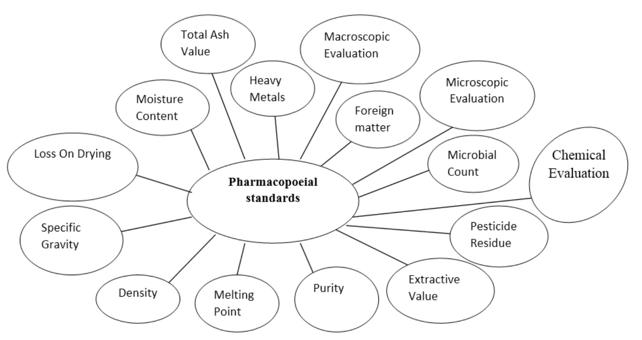
Fruit Flavanoids and memory
Recent evidence has indicated that a group of plant-derived compounds known as flavonoids may exert particularly powerful actions on mammalian cognition and may reverse age-related declines in memory and learning. In particular, evidence suggests that foods rich in three specific flavonoid subgroups, the flavanols, anthocyanins and/or flavanones, possess the greatest potential to act on the cognitive processes. Flavonoids are found most commonly in fruits, such as apples, berries and citrus fruits
It appears that they are able to impact upon memory through their ability to exert effects directly on the brain’s innate architecture for memory [Figure 6] [21]
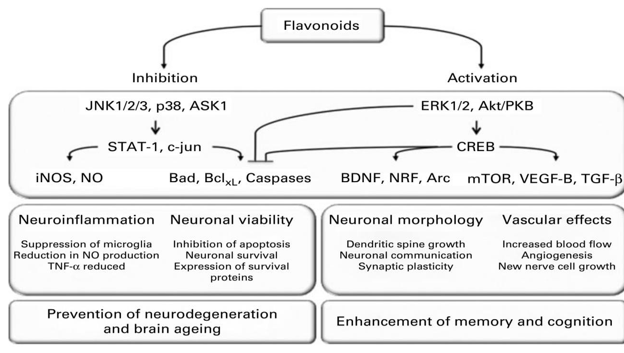
Flavanoids have potential to protect neurons against injury induced by neurotoxins, an ability to suppress neuroinflammation
Conclusion
The secondary prevention of dementia is reliant heavily on a more complete understanding of the neurodegenerative disease processes, which lead to clinical symptoms and eventually dementia.
Apart from the pharmacological approaches, other approaches such as dietary supplementation and encouragement of healthy lifestyle which is physically and mentally stimulating are going to have a big impact on cognitive research in future Nootropics also decreases platelet aggregation, increase cerebral blood flow and oxygen consumption. Nootropics are drugs act as memory enhancers, elevates mood and concentration levels. The therapy is challenging as there are many grey areas.
Nootropic herbs or smart drugs active constituents, helps to improve micro circulation of blood in the brain and have possible role in improving cognition
Source of Funding
None.
Conflict of Interest
None.
References
- . Tahmina Rahman Chowdhury , Research . 2015. [Google Scholar]
- William Sumrall. A Review of Memory Theory. Int J Humanities Soc Sci 2016. [Google Scholar]
- Cynthia P May, Gilles O Einstein. MEMORY A Five-Unit Lesson Plan for High School Psychology Teachers. 2013. [Google Scholar]
- Marco Catani. A revised limbic system model for memory. Emotion Behav Neurosci Biobehavioral Rev 2013. [Google Scholar]
- Ramanathan Sathianathan, Jyothi Suvarna, Kantipudi. The dementia epidemic: Impact, prevention, and challenges for India. Indian J Psychiatry 2020. [Google Scholar]
- Nihitha Sanka, *, N Santhipriya. Rama Rao Nadendla An updated review on Anti-Alzheimer’s herbal drugs. J Drug Deliv Ther 2018. [Google Scholar]
- Madeeha Malik, Azhar Hussain, Sehrish Malik, Ayisha Hashmi. Cognition and Memory Impairment Among Patients of Epilepsy in Pakistan-The Role of Conventional and Newer Anti-Epileptics. J Pharmacol Clin Res 2019. [Google Scholar]
- Barbara Monti, Antonio Contestabile. Memory-Enhancing Drugs: A Molecular Perspective. Mini Rev Med Chem 2009. [Google Scholar]
- R C Doijad, A B Pathan, N B Pawar, V D Maske, S S Baraskar. Gaikwad Therapeutic Applications of Citicoline and Piracetam as Fixed Dose Combination. Asian J Biomed Pharma Sci 2012. [Google Scholar]
- Masud Husain, A Mitul. Mehta Cognitive enhancement by drugs in health and disease. Trends Cognitive Sci 2011. [Google Scholar]
- Laxminarayana Kurady Bairy, Suresh Kumar. Neurotransmitters and neuromodulators involved in learning and memory. Int J Basic Clin Pharma 2019. [Google Scholar]
- Min Sheng. Sildenafil Improves Vascular and Metabolic Function in Patients with Alzheimer’s. Dis J Alzheimers Dis 2017. [Google Scholar]
- Manchester. NMS, Greater Manchester Group . 2019. [Google Scholar]
- Joshi Pranav, C. A Review on natural memory enhancers. Unique J Eng Adv Sci 2013. [Google Scholar]
- Siti Atiyah Ali, Tahamina Begum, Faruque Reza. Hormonal Influences on Cognitive Function. Malays J Med Sci 2018. [Google Scholar]
- R Shubhada, Ingole, K Satyendra, S S Rajput, Sharma. Cognition Enhancers: Current Strategies and Future Perspectives. CRIPS 2008. [Google Scholar]
- Vivek Jatwa, Praveen Khirwadkar, Kamlesh Dashora. Indian traditional memory enhancing herbs and their medicinal benefits. Indian J Res Pharm Biotechnol 2014. [Google Scholar]
- Permender Rathee. A review study on medicinal plants used in the treatment of learning and memory impairmentsAsian. Asian Pacific J Trop Biomed 1996. [Google Scholar]
- . [A]Nahid Jivad, A review study on medicinal plants used in the treatment of learning and memory impairments Asian Pacific J Trop Biomed 2014;4(10):780-9 [B] RD.Chaudhri, Herbal Drug Industry, 1996, Eastern Publishers, New Delhi [C] Sunil Chaudhry, Brahmi, The Fifth Dimension, 6th issue 1990 [D] Srithi Srinath, Memory Enhancing Medicinal Herbs J. Pharm. Sci. & Res. Vol. 6(10), 2014, 331-333 [E] Gupta Avneet , Singh Manish Pal, Sisodia S. Siddhraj, A review on herbal Ayurvedic medicinal plants and its association with memory functions, J Phytopharmacol 2018; 7(2): 162-166. . [Google Scholar]
- L Shailesh Patwekar, B Suryawanshi Arvind, S Gaikwad Manoj, R Pedewad Snehal, P Potulwar Ashwini. Standardization of herbal drugs: An overview. Pharma Innov J 2015. [Google Scholar]
- Jeremy P. E. Spencer. The impact of fruit flavonoids on memory and cognition. Br J Nutr 2010. [Google Scholar]
- Introduction
- Definition
- The three main stages of memory
- Memory formation
- Types of memory
- Memory circuit in Brain
- Causes of Memory loss
- Clinical causes of Memory Disorders
- Epilepsy and changes in memory:
- Other causes of dementia
- Drugs causing memory loss
- Drugs for memory
- Synthetic Memory enhancers
- NICE The National Institute for Health and Care Excellence UK
- Role of Neurotransmitters in Memory[11]
- Major neurotransmitters and their role in memory.
- Indications of Memory enhancers to be used specifically
- ADHD
- Chronic fatigue syndrome (CFS is a serious, long-term illness that affects many body systems
- Neurodegenerative disorders
- Improving memory in general population
- Nutrients and memory
- Hormones and memory
- Fruit Flavanoids and memory
- Conclusion
- Source of Funding
- Conflict of Interest
